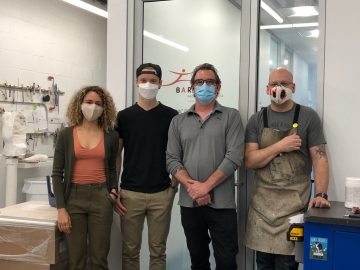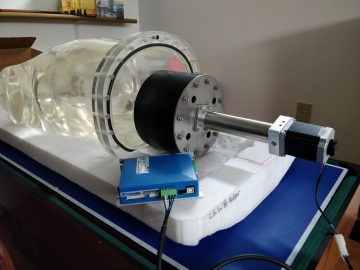Engineering Physics students David G. Black, Student Member, IEEE, Yas Oloumi Yazdi, and Jeremy Wong design a breathing, anthropomorphic phantom for Positron Emission Tomography in their capstone course ENPH 459. The project was sponsored by Dr. Ivan Klyuzhin, BC Cancer Research Centre.
The project won a UBC Faculty of Applied Science 2020 Design & Innovation Day (D+ID) Award.
The project poster was distinguished with a “Blue Ribbon”* indicating a high review score at the American Association of Physicists in Medicine (AAPM) and Canadian Organization of Medical Physicists (COMP) Joint Annual Meeting in Vancouver, BC, July 12 – 16, 2020.*
Faculty and staff working with this team were impressed by their organization and ease working together.
They showed high technical expertise developing the electrical, mechanical and software components, and displayed impressive initiative, reaching out to a German group to compare research notes, and tracking down companies to purchase components for assembling prototype lungs.
David Black: “Throughout the process we were always amazed at how friendly and helpful everyone was, from the Barber Prosthetics staff to the people who helped us choose the linear actuator and lent us a demo unit while it was made.

L – R: students Yas Oloumi Yazdi and David Black, with Barber Prosthetics staff Dave Moe and Daryl Murphy
Daryl, Dave, and Malena at Barber Prosthetics were particularly instrumental. We worked closely with them through multiple iterations of lung prototypes and tests. Not only did they make the lungs,

but they knew a company that could produce the fitting to connect the lungs to the trachea, custom for us, out of only plastic, free of charge.
We were introduced to Barber by Desmond Cook at BCIT, who generously helped us source the silicone material from Germany. Additionally, we benefited greatly from our UBC instructors – Dylan Gunn, Miti Isbasescu, and Bernhard Zender’s thorough and knowledgeable input from start to finish, particularly on the design of the actuation mechanism.

Finally, Ivan Klyuzhin’s guidance and domain expertise made the project possible.
From an engineering point of view, the project had an interesting mix of very careful, detailed mechanical design for the piston and actuation system, and a more free-form, experimental, prototyping approach for the lungs and fluid flow system.
One thing we learned was not to be afraid to get our hands dirty and build some quick prototypes to test an idea as early as possible. Such testing resulted in us completely changing the design we had made for our proposal from a diaphragm system to a piston mechanism. It was also useful in confirming that the pressure-driven breathing concept would work.”
Dr. Klyuzhin and the student group are poised to initiate three very interesting and related projects – stay tuned!
* “Those scoring high enough for a SNAP oral category are now indicated as a Blue Ribbon ePoster. In the virtual meeting program, your abstract will be annotated with a Blue Ribbon to indicate that it was a high scoring abstract.”
** The AAPM/COMP Annual Meeting & Exhibition draws about 4,000 participants to the world’s largest program of scientific, educational and professional presentations plus technical exhibits and social programs that targets the medical physics community.
The AAPM/COMP annual meeting features the latest research in the physics of medical imaging and radiation therapy, including a major focus on the increasing integration on advanced imaging technologies in the guidance of medical therapeutics.
The Program thanks the UBC Department of Physics and Astronomy Technical Services staff, especially Mladen and his team in the Department Machine Shop, who were always happy to talk about projects and to provide very practical advice about design and fabrication. We relied heavily on them for the design and fabrication of the cylinder parts and they did, as always, an excellent job. All of the parts were delivered on-spec, with no mistakes.
Abstract:
Patient motion during Positron Emission Tomography
(PET) scans can be a major detriment to image
quality, leading to quantification errors and radiologists potentially
missing malignant lesions. The primary source of
movement in thoracic PET scans is respiratory, followed by
cardiac motion. These problematic effects can be mitigated
to a degree using motion correction algorithms. In order to
further develop, improve, and test such algorithms, anthropomorphic
phantoms with accurate anatomy and realistic
motion are needed. In this work we present such a phantom,
which builds off the state of the art in humanoid phantom
anatomy by adding elastic lungs with a highly controllable,
realistic breathing mechanism to an existing, proven
anatomically accurate phantom. The breathing mechanism
can produce a plethora of custom respiratory wave-forms
with breathing rates up to 25 breaths per minute and tidal
volumes up to 1200mL. It does not decrease the anatomical
accuracy in any way through the addition of mechanisms
or actuators inside the torso. The full mechanical design
is described in this paper, as well as a software application
with graphical user interface which was developed to
plan and visualize respiratory patterns. Finally, tests were
carried out to validate the effectiveness and accuracy of
the mechanism. With flexibility in the desired respiratory
pattern, as well as the potential to add cardiac motion,
this phantom will facilitate future work in developing new
motion correction algorithms and evaluating the effect of
motion on image quantification.